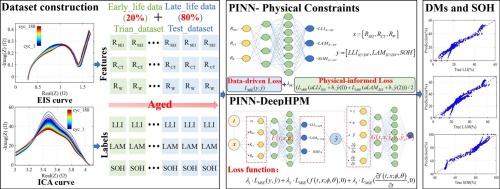基于电化学阻抗谱的锂离子电池退化诊断的物理信息神经网络
IF 8.9
2区 工程技术
Q1 ENERGY & FUELS
引用次数: 0
摘要
锂离子电池(LIBs)在长期使用过程中不可避免地会出现性能下降,这是由许多相互关联的耦合机制驱动的。仅依靠健康状况(SOH)不足以进行有效的降解诊断。提取降解模式(dm)为理解降解机制、优化电池设计和制定控制策略提供了更全面的指导。电化学阻抗谱(EIS)作为一种无创诊断工具,提供了有价值的内部动力学信息,是对时域数据的有效补充。本文提出了一种通用的、高精度的阻抗解耦和参数逼近方法,从EIS中高效提取与电池退化相关的关键健康指标。构建了两个具有不同结构的物理信息神经网络(pinn),将HIs映射到SOH和dm。为了解决获取标记老化数据的挑战,所提出的pinn仅使用20%的早期老化数据进行模型训练,即可实现准确的SOH和dm预测。使用广泛采用的开放获取数据集和内部数据集系统地验证了所提出方法的有效性和泛化性。结果表明,PINN框架在不同细胞类型、SOC水平和老化状态下估计SOH和dm的均方根误差始终低于2%,显示出强大的鲁棒性、适应性和预测可靠性。该研究为基于早期EIS数据的在线退化诊断提供了一种新颖的PINN设计策略,为电池管理提供了重要的理论见解和实用价值。本文章由计算机程序翻译,如有差异,请以英文原文为准。

Physics-informed neural networks for degradation diagnosis of lithium-ion batteries via electrochemical impedance spectroscopy
Lithium-ion batteries (LIBs) inevitably experience performance degradation during long-term service, driven by numerous interrelated coupled mechanisms. Relying solely on state of health (SOH) is insufficient for effective degradation diagnosis. Extracting degradation modes (DMs) provides more comprehensive guidance for understanding degradation mechanisms, optimizing battery design, and developing control strategies. Electrochemical impedance spectroscopy (EIS), as a non-invasive diagnostic tool, offers valuable internal kinetic information and serves as an effective supplement to time-domain data. In this study, a general and high-accuracy impedance decoupling and parameter approximation method is proposed to efficiently extract key health indicators (HIs) associated with battery degradation from EIS. Two physics-informed neural networks (PINNs) with different architectures are constructed to map HIs to SOH and DMs. To address the challenge of acquiring labeled aging data, the proposed PINNs achieve accurate SOH and DMs prediction using only 20 % of early-stage aging data for model training. The effectiveness and generalization of the proposed method are systematically validated using both widely adopted open-access datasets and in-house datasets. The results indicate that PINN framework consistently achieve root-mean-square errors below 2 % in estimating SOH and DMs across varying cell types, SOC levels, and aging states, demonstrating strong robustness, adaptability, and predictive reliability. This work provides a novel PINN design strategy for online degradation diagnosis based on early-stage EIS data, offering significant theoretical insights and practical value for battery management.
求助全文
通过发布文献求助,成功后即可免费获取论文全文。
去求助
来源期刊

Journal of energy storage
Energy-Renewable Energy, Sustainability and the Environment
CiteScore
11.80
自引率
24.50%
发文量
2262
审稿时长
69 days
期刊介绍:
Journal of energy storage focusses on all aspects of energy storage, in particular systems integration, electric grid integration, modelling and analysis, novel energy storage technologies, sizing and management strategies, business models for operation of storage systems and energy storage developments worldwide.
 求助内容:
求助内容: 应助结果提醒方式:
应助结果提醒方式:


